Photo : A network of partners from Fribourg and other parts of Switzerland have set themselves the challenge of turning chicken feathers into plastic wrapping for poultry products.

In 2020, nearly 19 million metric tons of chicken were processed in the European Union. But only two-thirds of it ended up on our plates. Very little of the remaining one third, of which around 10% are feathers, is not recycled; much is simply burnt, which also has a negative CO2 impact. According to Rudy Koopmans, Director of the Plastics Innovation Competence Center (PICC) based in Fribourg’s blueFACTORY, “While this is happening, the agrifood industry relies on massive quantities of synthetic polymers for its packaging.”
So, could there be a way to upcycle this mountain of waste by transforming it into biobased plastics? This was the mission that researchers at PICC set for themselves. They were joined in this ambitious venture by the ChemTech Institute of the Fribourg School of Engineering and Architecture (HEIA-FR), the Bern University of Applied Sciences (BFH), as well as companies Micarna, Centravo, Alma Packaging and Maillefer. Kera, as this exciting project is called, benefits from New Regional Policy (NRP) support.
An exportable model
Koopmans explains that chicken feathers are an extremely rich source of keratin. So, the Fribourg research team set about extracting this protein, which they then used to begin the small-scale production of various plastic objects. In the medium term, the goal is to create injection-molded parts and plastic film packaging for the agrifood industry. “These products would not only be renewable, but also compostable and non-toxic. We would also be able to create a local bioeconomy chain, as poultry producers and processors would no longer have to ship their waste to incineration plants outside Switzerland.”
This approach, which is already widely used in the chemical industry among others, “is pretty groundbreaking for the agricultural sector”. In the long term, the Kera model could be exported to other countries and to other sectors of the economy as well. However, the PICC director stresses the importance of taking account of the needs and sensitivities of everyone concerned, especially the end customer, before undertaking such a move. This is why the BFH is currently conducting a sociological study to determine consumer acceptance of packaging made from chicken feathers.
